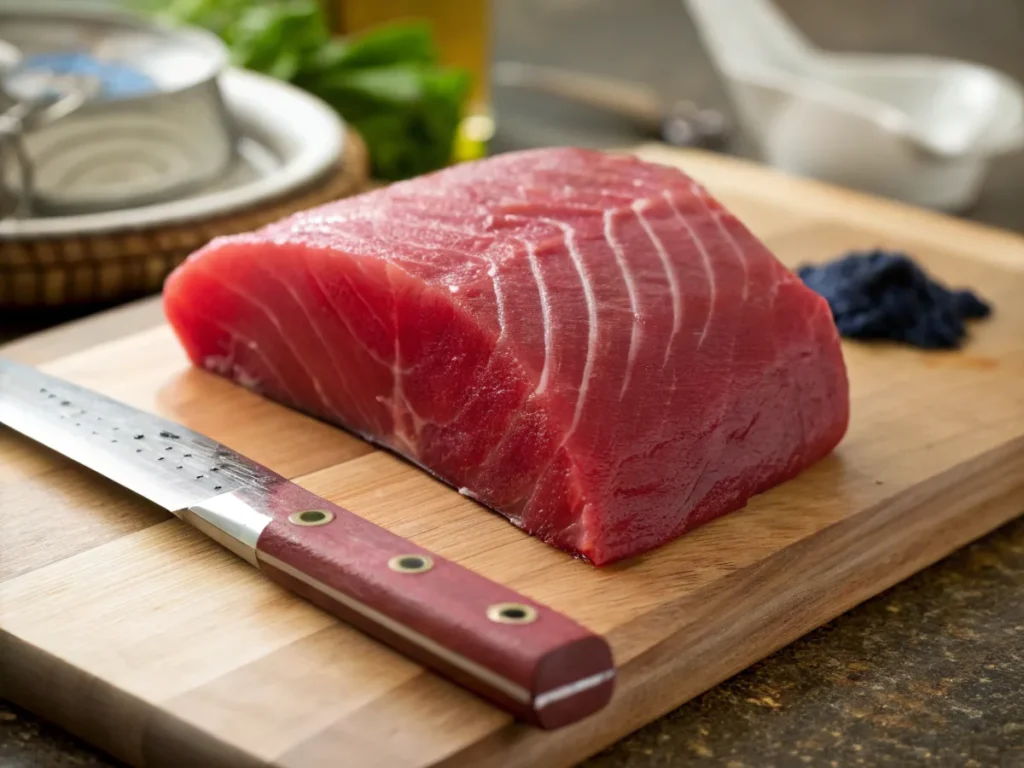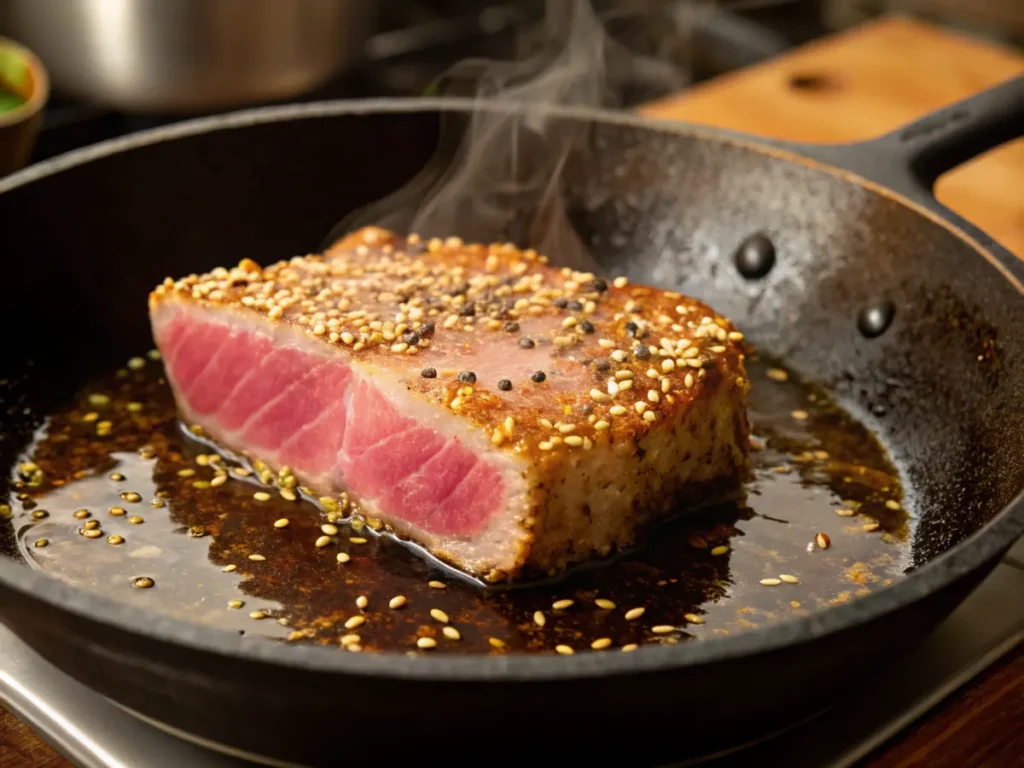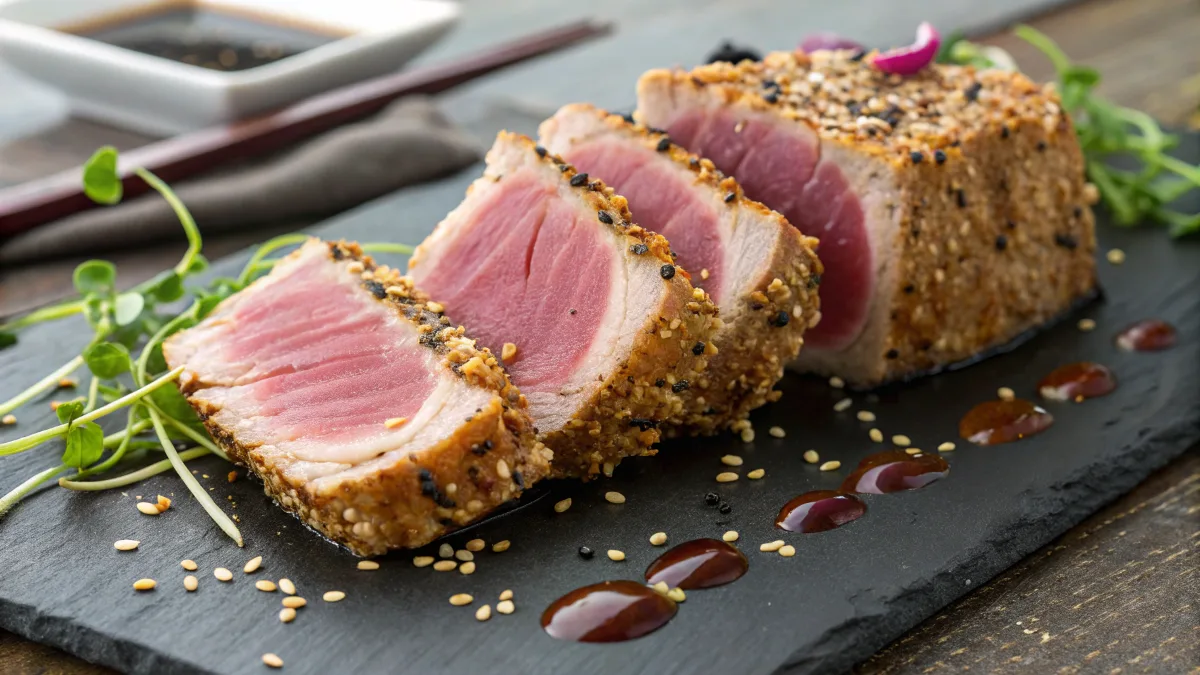Introduction
A seared ahi tuna recipe is the perfect way to enjoy a restaurant-quality dish at home. Known for its delicate texture and bold flavor, seared ahi tuna is a staple in gourmet dining. The key to achieving that perfectly crusted exterior while keeping the inside tender and rare lies in selecting the right ingredients and using the proper cooking techniques.
This seared ahi tuna recipe is quick, easy, and packed with flavor, making it an excellent choice for a light yet satisfying meal. Whether you’re a seafood lover or just looking to elevate your home cooking, this guide will help you master the art of searing ahi tuna like a pro.
Choosing the Best Ahi Tuna for Searing

Difference Between Fresh vs. Frozen Ahi Tuna
When selecting tuna for a seared ahi tuna recipe, one of the biggest decisions is whether to choose fresh or frozen fish. Each option has its advantages and drawbacks, and understanding these can help you make an informed choice.
| Type of Ahi Tuna | Pros | Cons |
|---|---|---|
| Fresh Ahi Tuna | Superior texture and taste | Shorter shelf life |
| Best for immediate cooking | Must be consumed quickly | |
| Frozen Ahi Tuna | More accessible and convenient | Slight texture changes |
| Can be stored longer | Requires proper thawing |
Fresh ahi tuna is highly sought after for its rich, buttery texture and vibrant color. If you live near a coast or have access to a reputable fishmonger, fresh tuna is often the best choice. However, frozen ahi tuna can also be a great option, especially if it has been flash-frozen. This method locks in freshness, ensuring the tuna maintains its quality when thawed properly.
How to Identify Sushi-Grade Ahi Tuna
Not all tuna is created equal, and if you want to achieve restaurant-quality results, choosing sushi-grade ahi tuna is crucial. The term “sushi-grade” isn’t regulated, but it generally refers to tuna that has been frozen at very low temperatures to kill parasites, making it safe for raw consumption.
Here are key characteristics of high-quality sushi-grade ahi tuna:
- Color: The flesh should be deep red or pink with a slightly translucent quality. Avoid tuna that looks dull or brown.
- Texture: Fresh ahi tuna should be firm and smooth, with no mushy or sticky feel.
- Smell: Quality tuna has a clean, ocean-like aroma. A strong fishy smell is a sign of aging or poor handling.
- Labeling: Look for tuna labeled as “sushi-grade” or “sashimi-grade” from trusted seafood suppliers.
Best Places to Buy High-Quality Ahi Tuna
Finding the right ahi tuna is key to making a seared ahi tuna recipe that tastes as good as a restaurant dish. Here are some of the best places to purchase high-quality ahi tuna:
- Local Fish Markets – These often carry the freshest options, especially if you live near the coast.
- Japanese or Asian Grocery Stores – These stores specialize in sushi-grade fish and often have top-tier selections.
- Online Seafood Retailers – Many reputable companies ship high-quality, frozen sushi-grade ahi tuna directly to your door.
- Upscale Supermarkets – Some grocery stores with high-end seafood sections stock sushi-grade tuna.
Always ask the seller about the source of the tuna and whether it has been frozen properly to ensure the best quality.
Selecting high-quality seafood is key to a great dish. If you love cooking with fresh fish, check out our Bluefin Tuna Recipe for another delicious way to enjoy tuna!
Essential Ingredients for a Perfect Seared Ahi Tuna recipe
Key Ingredients for Seasoning
The beauty of a seared ahi tuna recipe lies in its simplicity. Ahi tuna has a rich, meaty flavor that doesn’t require heavy seasoning. However, the right ingredients can enhance its natural taste.
Essential seasonings for seared ahi tuna:
- Salt: Sea salt or kosher salt enhances the natural umami flavor.
- Black Pepper: Adds a subtle heat and balances the saltiness.
- Sesame Seeds: A crunchy outer layer that complements the soft texture of the tuna.
- Soy Sauce: Provides a salty, umami-rich depth of flavor.
- Wasabi or Dijon Mustard: Adds a mild kick without overpowering the fish.
For a bolder flavor, you can incorporate a spice blend such as garlic powder, smoked paprika, or chili flakes.
Choosing the Best Oil for Searing
The oil you use plays a critical role in achieving the perfect sear. Since ahi tuna is cooked quickly over high heat, the oil must have a high smoke point.
| Oil Type | Smoke Point | Best Feature |
|---|---|---|
| Avocado Oil | 520°F (271°C) | Neutral taste, high smoke point |
| Sesame Oil | 410°F (210°C) | Nutty, aromatic flavor |
| Canola Oil | 400°F (204°C) | Light and budget-friendly |
| Peanut Oil | 450°F (232°C) | Subtle nutty flavor, high heat-resistant |
Sesame oil and soy sauce add incredible flavor to seafood dishes. For another tuna-based meal packed with umami, try our Tuna Helper Recipe!
Optional Toppings and Sauces for Extra Flavor
While seared ahi tuna is delicious on its own, toppings and sauces can take it to the next level.
- Ponzu Sauce: A citrusy soy-based sauce that brightens up the dish.
- Ginger Soy Glaze: A sweet and savory glaze for added depth.
- Spicy Mayo: A creamy kick made with mayonnaise and sriracha.
- Pickled Ginger: Cleanses the palate between bites.
Experiment with different combinations to suit your taste!
Step-by-Step Guide to Searing Ahi Tuna

Preparing the Tuna: To Marinate or Not?
Marinating ahi tuna is optional, but it can add additional flavor. A simple marinade of soy sauce, sesame oil, and garlic can enhance its natural taste. If marinating, keep it under 30 minutes to avoid breaking down the delicate texture.
Best Searing Techniques for Even Cooking
For a perfect sear, follow these steps:
- Pat the Tuna Dry – Moisture prevents a proper crust from forming.
- Season Generously – Coat with sesame seeds or a spice rub.
- Preheat the Pan – Use a cast iron or stainless steel pan over high heat.
- Add Oil – Ensure the oil is shimmering but not smoking excessively.
- Sear Each Side Briefly – Cook for 45-60 seconds per side for rare.
How Long to Sear for Different Doneness Levels
| Doneness | Cooking Time per Side | Internal Temperature |
|---|---|---|
| Rare | 45-60 seconds | 115-120°F (46-49°C) |
| Medium-Rare | 1-2 minutes | 125-130°F (51-54°C) |
| Well-Done | 3-4 minutes | 140°F+ (60°C) |
For the best results, aim for rare to medium-rare, keeping the inside raw but slightly warm.
Butter vs. Oil – Which is Better for Searing?
Pros and Cons of Using Butter for Searing
Butter adds richness, but it has a low smoke point (350°F/177°C), making it unsuitable for high-heat searing.
| Pros of Butter | Cons of Butter |
|---|---|
| Adds depth of flavor | Burns easily at high heat |
| Enhances browning | Can make the fish greasy |
Why Oil Is the Preferred Choice for High Heat
Oils like avocado or sesame oil have high smoke points, ensuring a clean sear without burning. They also allow for better caramelization.
How to Combine Butter and Oil for Extra Flavor
For the best of both worlds, try combining oil and butter. Here’s how:
- Heat a high-smoke-point oil first.
- Once the tuna is almost done, add a small pat of butter.
- Spoon the melted butter over the fish for extra richness.
This method enhances flavor without burning the butter too quickly.
Gordon Ramsay’s Technique for Seared Ahi Tua recipe
Overview of Gordon Ramsay’s Signature Method
Celebrity chef Gordon Ramsay is known for his precision in cooking, and his seared ahi tuna recipe follows a simple but effective technique. His method emphasizes high heat, minimal seasoning, and a quick sear to keep the tuna tender and flavorful.
Here’s an overview of Gordon Ramsay’s approach:
- High-Quality Ahi Tuna – Sushi-grade tuna is essential for the best results.
- Simple Seasoning – Salt, pepper, and a touch of sesame seeds for a crust.
- Very Hot Pan – Using a heavy pan ensures a quick, even sear.
- Quick Cooking Time – Each side is seared for about 30-45 seconds.
- Resting Period – Allow the tuna to rest for a minute before slicing.
By following this method, you can achieve a beautifully seared ahi tuna with a crispy outer layer and a rare, melt-in-your-mouth center.
Key Tips for Achieving a Golden Crust
To get that signature restaurant-quality sear, consider these tips:
- Dry the Tuna – Excess moisture prevents proper searing. Pat the fish dry before cooking.
- Use a Hot, Heavy Pan – A cast iron skillet works best for even heat distribution.
- Press Down While Searing – Lightly pressing the tuna onto the pan helps create an even crust.
- Don’t Overcrowd the Pan – Searing too many pieces at once can reduce heat and affect the texture.
How to Plate and Serve Like a Pro
Presentation is just as important as flavor when making seared ahi tuna at home. Follow these plating tips to elevate your dish:
- Slice Thinly – Use a sharp knife to cut the tuna into thin, even slices.
- Arrange Over a Sauce – Drizzle ponzu, soy sauce, or spicy mayo on the plate before placing the tuna.
- Add Garnishes – Sprinkle microgreens, sesame seeds, or thinly sliced scallions for a professional look.
- Use Contrast – Serve with vibrant vegetables or a side salad to enhance visual appeal.
Serving Suggestions and Side Dishes

Best Side Dishes to Pair with Seared Ahi Tuna
A seared ahi tuna recipe pairs well with both light and bold-flavored sides. Here are some top choices:
| Side Dish | Flavor Profile | Why It Works |
|---|---|---|
| Steamed Jasmine Rice | Mild, fluffy | Balances the richness of the tuna |
| Garlic Sautéed Spinach | Savory, slightly bitter | Adds freshness and color |
| Asian Slaw | Crunchy, tangy | Provides texture contrast |
| Avocado Salad | Creamy, mild | Complements the buttery tuna |
| Wasabi Mashed Potatoes | Spicy, smooth | Adds depth and heat |
Looking for more delicious recipes? Our Smoked Meatloaf Recipe is a smoky, protein-packed dish that pairs well with a variety of flavors
Complementary Sauces and Dips
A flavorful sauce can take your seared ahi tuna to the next level. Try these options:
- Ponzu Sauce: A citrusy soy-based sauce with umami depth.
- Ginger Soy Glaze: Sweet and savory, perfect for drizzling.
- Sriracha Mayo: A creamy, spicy kick for extra heat.
- Miso Dressing: A rich, umami-packed sauce for dipping.
How to Serve for a Restaurant-Quality Presentation
For a gourmet presentation, consider these plating techniques:
- Layered Slices – Arrange tuna slices in a fan-like pattern for a stylish look.
- Drizzle Sauces Artfully – Use a squeeze bottle or spoon to drizzle sauce around the plate.
- Garnish with Microgreens – Small edible greens add elegance and freshness.
- Use Contrasting Colors – Serve with vibrant vegetables for visual appeal.
Common Mistakes to Avoid When Searing Ahi Tuna
Overcooking vs. Undercooking
Ahi tuna is best enjoyed rare to medium-rare. Overcooking can turn the fish dry and chewy, while undercooking without proper searing may result in an unappetizing texture.
| Mistake | Consequence | Solution |
|---|---|---|
| Cooking too long | Tough, dry tuna | Sear for 45-60 seconds per side |
| Not hot enough pan | No crust formation | Preheat pan on high heat |
| Searing from frozen | Uneven cooking | Thaw completely before cooking |
Using the Wrong Pan or Oil
The choice of pan and oil makes a huge difference in the searing process. A non-stick pan won’t provide the high heat needed for a proper crust. Use cast iron or stainless steel instead.
For the best results:
- Use high smoke point oils like avocado or sesame oil.
- Avoid butter alone, as it burns quickly at high temperatures.
- Always heat the oil before adding the tuna to prevent sticking.
Skipping the Resting Period
Allowing the seared ahi tuna to rest for one to two minutes after cooking helps redistribute juices and prevents the fish from becoming dry when sliced.
FAQs – Answering Popular Questions
What is the best way to cook ahi tuna?
The best way to cook ahi tuna is by quickly searing it over high heat. This method locks in moisture and flavor while keeping the inside rare or medium-rare for the best texture.
Should I marinate ahi tuna before searing?
Marinating ahi tuna is optional but can enhance its flavor. If marinating, keep it short (15-30 minutes) to avoid breaking down the delicate texture.
Is it better to sear tuna in butter or oil?
Oil is better for high-heat searing since it has a higher smoke point. Butter burns quickly but can be added at the end for flavor. A combination of oil and butter works best.
How does Gordon Ramsay sear tuna?
Gordon Ramsay sears tuna over high heat for 30-45 seconds per side, ensuring a crispy crust while keeping the center rare. He often uses sesame seeds, soy sauce, and a hot pan for the perfect finish.

Seared Ahi Tuna Recipe – How to Make It Restaurant-Quality
A quick and flavorful seared ahi tuna recipe with a perfectly crusted exterior and a tender, rare inside, ideal for seafood lovers.
- Total Time: 12 minutes
- Yield: 2 servings 1x
Ingredients
- 2 ahi tuna steaks (sushi-grade)
- 2 tbsp sesame seeds
- 1 tbsp soy sauce
- 1 tbsp sesame oil
- 1 tsp black pepper
- 1/2 tsp sea salt
- 1/2 tsp garlic powder
- 1 tbsp avocado oil (for searing)
- 1/2 tsp wasabi (optional)
- 1/2 tsp Dijon mustard (optional)
Instructions
- Pat the ahi tuna steaks dry with paper towels.
- Season the tuna evenly with salt, black pepper, garlic powder, and sesame seeds.
- Heat avocado oil in a cast iron or stainless steel pan over high heat.
- Once the oil is shimmering, sear the tuna for 45-60 seconds per side for a rare center.
- Remove from the heat and let rest for 1-2 minutes.
- Slice thinly and serve with soy sauce, wasabi, or Dijon mustard.
Notes
For the best results, use sushi-grade ahi tuna and avoid overcooking to maintain a tender texture.
- Prep Time: 10 minutes
- Cook Time: 2 minutes
- Category: Main Course
- Method: Pan-Seared
- Cuisine: Japanese
Nutrition
- Serving Size: 1 serving
- Calories: 220
- Sugar: 0g
- Sodium: 500mg
- Fat: 12g
- Saturated Fat: 2g
- Unsaturated Fat: 9g
- Trans Fat: 0g
- Carbohydrates: 2g
- Fiber: 0g
- Protein: 25g
- Cholesterol: 45mg
Keywords: ahi tuna, seared tuna, seafood, healthy, quick recipe
Conclusion
A seared ahi tuna recipe is an elegant yet simple dish that brings restaurant-quality flavors to your home kitchen. By choosing sushi-grade tuna, using the right searing technique, and pairing it with complementary sides and sauces, you can elevate this dish to gourmet status.
Whether following Gordon Ramsay’s method or experimenting with different seasonings, the key is high-quality ingredients and precise cooking. Avoid common mistakes like overcooking or using the wrong oil, and you’ll achieve that perfectly seared crust with a tender center.

